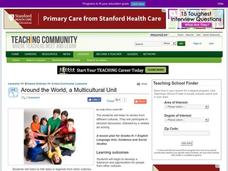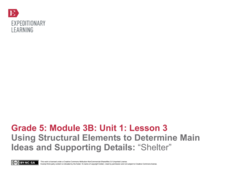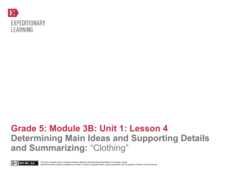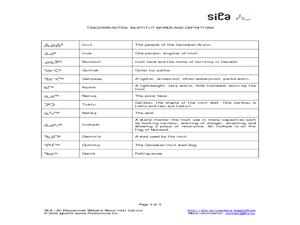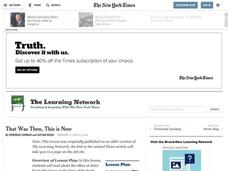Curated OER
Learning to Give: Generosity of Spirit Folktales
Young scholars read two Inuit folktales about life and death. In this language arts lesson, students study the models of giving found in these Inuit tales about life, death, grief, sacrifice, and generosity. As the class reads these...
Curated OER
Winter Season
Learners recognize the relationship between Earth's tilt and the Winter season. In this Winter instructional activity, students work in pairs to complete make frost and design snow goggles. Learners experiment a hand lens to study the...
Curated OER
More than One Way of Knowing
Students compare the obeservations of traditional people with the oberservations of Western science. They validate Traditional Ecological Knowledge (TEK) and Inuit Qaujimajatuqangit (IQ) through comparison and the identification of...
Curated OER
The Inuksuk: Symbolism and Cultural Identity Lesson Plan
Learners create their own inuksuk (stone formation). In this Inuit lesson, students discuss the culture of the people and the symbolism behind their inuksuks. They create their own stone formation from outside materials.
Curated OER
An Introduction to Shamanism
Students investigate Inuit customs. In this cultural traditions lesson, students read about religious customs of the Inuit including Shamanism. Students discuss the role of Shaman and create Inuktitut-English dictionaries with terms...
Curated OER
Native Americn Religious Beliefs and Practices
Students research how religions are created and how they influence the way people live. They identify the religious beliefs and practices of the Inuit, Lakota, Apache, Navajo and Iroquois Native Americans. Students find the...
Curated OER
Impressive prints!
Learners explore Inuit artworks and legends, and create prints of a fictional animal. They familiarize themselves with the concepts of positive and negative spaces through printmaking techniques.
Curated OER
Around the World, A Multicultural Unit
Students investigate Native American tribes through their stories. In this cultural instructional activity, students read stories of the Inuit tribe and discuss the themes, people, and customs. Students illustrate a picture of the...
Curated OER
Inuit and Arctic Animals
Students will explore the animals and people living in the Arctic. In this science lesson, students locate Alaska on a globe, discuss its climate and geographical features, and identify common arctic animals. Students complete the first...
National Gallery of Art
Impressive Prints
Explore printmaking with a discussion and project. Pupils first view and talk about various examples of prints and cover positive and negative space. They then come up with fictional animals and make prints of their creature using...
EngageNY
Synthesizing Text Details to Explain Relationships: “Hunting”
The class is on the hunt. Scholars read pages 22-23 of The Inuit Thought of It about different hunting techniques of the Inuit people. They sketch a picture of the gist of the section and then complete a web that shows the relationship...
National Gallery of Canada
Transformation
Create colorful cool or warm butterflies with simple materials. Class members draw their designs, spray the marker to diffuse the colors, and attach pipe cleaners to form the shape of a butterfly with antennae. Individuals must be able...
National Gallery of Canada
Reading Sculptures
Consider the elements and principles of design closely while examining works of art. Learners select an image from the provided pieces to write about in relation to the elements and principles of design. They then sketch and sculpt their...
EngageNY
Determining Main Ideas and Details to Write a Summary Paragraph: “Food”
Let's eat! Scholars read pages 24-25 of The Inuit Thought of It to discover the foods eaten by the Inuit. They sketch a visual gist of the section in their journals and write a summary paragraph about the text.
Curated OER
Canadian Legends (Inuit and/or Native)
Third graders examine the attributes of Canadian legends by reading both Internet and written versions. They examine Arctic animals in order to determine which one they will write about. They work in pairs to write the first half of a...
EngageNY
Close Reading: “Dog Sleds” and “Kayak”
Visualize it! Scholars read pages 12–15 of The Inuit Thought of It and create a visual gist of the text. They then do a close read of the text and create a natural environment anchor chart before answering text-dependent questions.
EngageNY
Using Structural Elements to Determine Main Ideas and Supporting Details: “Shelter”
Does the picture tell the story? Learners continue their work in The Inuit Thought of It by creating a visual gist of pages 16 and 17. They then complete a main idea graphic organizer and discuss key supporting details.
EngageNY
Determining Main Ideas and Supporting Details and Summarizing: “Clothing”
Surviving winter. Pupils begin reading on page 18 of The Inuit Thought of It: Amazing Arctic Inventions and sketch how the people used animal skin clothing to survive the winter. Readers complete a main idea graphic organizer with...
EngageNY
Synthesizing Text Details to Explain Relationships: “Medicine and Healing”
After reading the section about medicine and healing in The Inuit Thought of It, leaners determine what they feel was the most important resource to surviving in the Arctic environment. They support their opinions with details from the...
Curated OER
The First Nations, Métis, and Inuit Peoples of Canada
Students explore demographic shifts. In this Canadian Census lesson, students interpret data from the 2006 Census to determine the needs of the Aboriginal population in the country.
Curated OER
Life in the Freezer
In this global warming worksheet, climatologists examine a few possible results of climate change. There is no specific reading from which learners extrapolate the information needed to answer the questions, so you will need to preface...
Curated OER
Going into the Great North
Students observe and investigate the areas included in the Great North. For this geography lesson, students observe a documentary based on the Great North. Later the students will draw and identify countries within the arctic circle and...
Curated OER
Inuktitut
Students explore Inuit language. In this Inuktitut lesson, students listen to a lecture about the history and phonology of the Inuit language. Students create Inuktitut-English dictionaries with illustrations for younger student use.
Curated OER
That Was Then, This is Now
Students read about the effect of strict fur trading laws on the lives of the Inuit people in Canada, then use print and digital resources to compare past and present-day ways of life of several indigenous peoples around the world.
Other popular searches
- Contemporary Inuit Art
- Canadian History Inuits
- Inuit Culture
- Inuit Art
- Inuit Indians
- Eskimos Inuit
- Modeling Clay Inuit
- Social Studies Inuit
- Canadian Inuit History
- Role of the Inuit
- Inuit Communities
- Inuit, Kwakiutl









